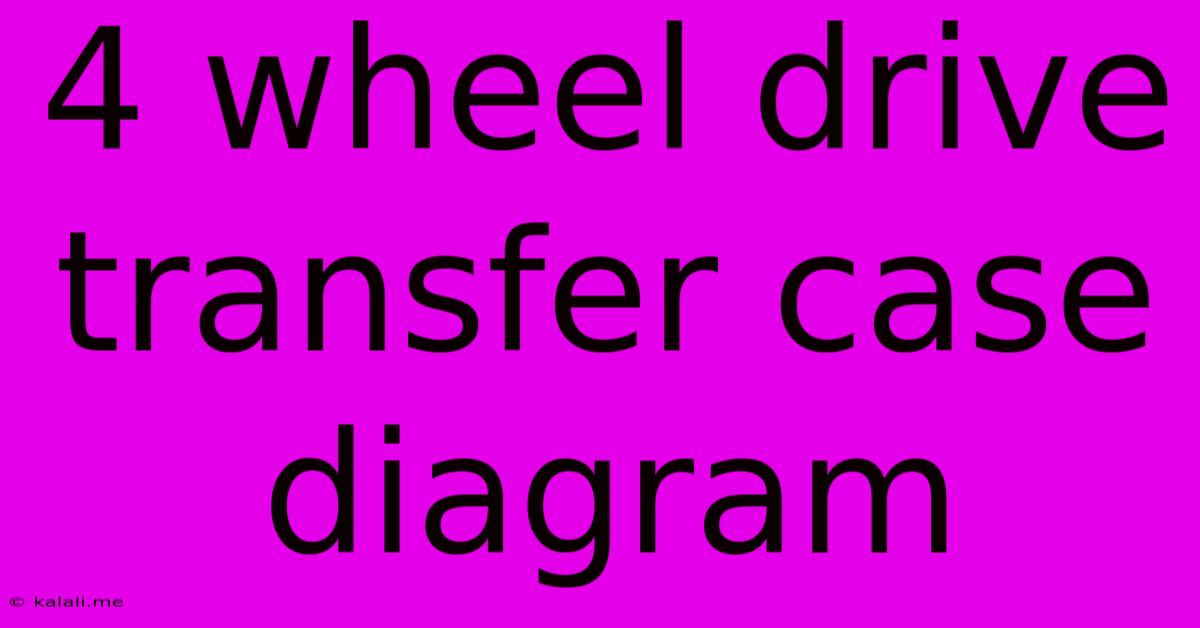4 Wheel Drive Transfer Case Diagram
Kalali
Jun 14, 2025 · 3 min read

Table of Contents
Understanding Your 4 Wheel Drive Transfer Case: A Diagram and Explanation
Meta Description: This article provides a detailed explanation of a 4WD transfer case, including a simplified diagram, and covers its function, different modes (2H, 4H, 4L), and common issues. Learn how this crucial component works to distribute power to all four wheels.
The transfer case is a critical component in any four-wheel-drive (4WD) vehicle. It's responsible for distributing power from the transmission to both the front and rear axles, enabling the vehicle to operate in various driving conditions. Understanding its function and components is key to maintaining your 4WD system's performance and longevity. This article will break down the basics, using a simplified diagram to illustrate the key parts and their roles.
A Simplified Transfer Case Diagram
While the exact configuration varies depending on the make and model of your vehicle, a typical transfer case generally includes these key elements:
Input Shaft (from Transmission)
|
V
-------------------------------------------------
| |
| Chain Drive/Gear Set |
| |
-------------------------------------------------
| / \ |
| / \ |
| / \ |
| / \ |
| / \ |
| / \ |
| / \ |
Output Shaft (Front Axle) Output Shaft (Rear Axle)
\ / |
\ / |
\ / |
\ / |
\ / |
\ / |
\______/ |
|
V
Control System (Shift Lever/Buttons)
Note: This is a highly simplified representation. Actual transfer cases contain many more internal components, including bearings, seals, and various gears.
How the Transfer Case Works
The transfer case receives power from the transmission's output shaft. Inside, gears and a chain drive (or other gear sets) split this power, distributing it to the front and rear axles via output shafts. The control system (typically a shift lever or electronic buttons) allows the driver to select different drive modes.
Common Transfer Case Modes:
-
2H (2-Wheel High): Power is sent only to the rear wheels. This is the default mode for most on-road driving. Best fuel economy is achieved in this mode.
-
4H (4-Wheel High): Power is distributed to all four wheels, ideal for low-traction conditions like snow, mud, or gravel. This mode is generally used at higher speeds.
-
4L (4-Wheel Low): This mode provides a significant reduction in gear ratio, increasing torque substantially. 4L is perfect for extremely challenging off-road situations requiring maximum traction and low speed, like steep inclines or rocky terrain.
Understanding the Importance of Proper Maintenance
Regular maintenance is crucial for the longevity of your transfer case. This includes checking the fluid level (using the correct type of transfer case fluid) and condition, and inspecting for leaks. Ignoring these steps can lead to serious damage, requiring costly repairs.
Common Transfer Case Problems:
-
Fluid Leaks: A tell-tale sign of wear and tear.
-
Grinding or Whining Noises: Indicates internal gear issues.
-
Difficulty Shifting: May signal worn-out components or low fluid levels.
-
Failure to Engage 4WD: Could be due to electrical faults or mechanical issues.
Regular maintenance and addressing problems early can prevent costly repairs and ensure the reliable performance of your 4WD system. If you encounter any problems with your transfer case, consult a qualified mechanic for diagnosis and repair. Remember to always consult your vehicle's owner's manual for specific recommendations on maintenance and operation.
Latest Posts
Latest Posts
-
Urea Is A Byproduct Of The Metabolism Of
Jun 15, 2025
-
Which State Of Matter Has Highest Kinetic Energy
Jun 15, 2025
-
Which Letter Is Midway Between J And P
Jun 15, 2025
-
Between Which Two Planets Are Most Asteroids Located
Jun 15, 2025
-
1st Gold Medal In Olympic For India
Jun 15, 2025
Related Post
Thank you for visiting our website which covers about 4 Wheel Drive Transfer Case Diagram . We hope the information provided has been useful to you. Feel free to contact us if you have any questions or need further assistance. See you next time and don't miss to bookmark.